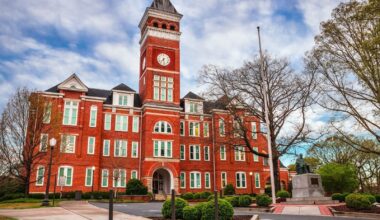Best Engineering Schools in the USA – When it comes to engineering education, the United States stands tall with a diverse array of exceptional institutions that consistently produce top-notch engineers. In this comprehensive guide, we will explore the history, address, acceptance rates, and admission processes of the best engineering schools in the USA, helping aspiring engineers make informed decisions about their academic journey.
Best Engineering Schools in the USA
- Massachusetts Institute of Technology (MIT):
History: Established in 1861, MIT has been at the forefront of engineering education for over 160 years. Its commitment to cutting-edge research and innovation has made it a pioneer in various fields of engineering.
Address: 77 Massachusetts Avenue, Cambridge, MA 02139
Acceptance Rate: MIT is renowned for its selective admissions process, with an acceptance rate of around 6.7%. This competitive nature ensures that only the brightest minds become part of the MIT community.
Admission Process: Aspiring students must submit their applications through the Common Application or Coalition Application. Besides a stellar academic record, MIT places emphasis on standardized test scores (SAT or ACT), recommendation letters, extracurricular involvement, and a compelling personal statement.
- Stanford University:
History: Founded in 1885, Stanford University has consistently been one of the leading institutions for engineering education. It boasts a rich history of producing influential engineers and entrepreneurs.
Address: 450 Serra Mall, Stanford, CA 94305
Acceptance Rate: Stanford’s prestige comes with fierce competition, resulting in an acceptance rate of approximately 4.3%. Only a select few earn the privilege of studying at this prestigious university.
Admission Process: Students can apply to Stanford using the Common Application or Coalition Application. Alongside academic achievements, applicants must showcase outstanding standardized test scores, compelling recommendation letters, and a well-crafted essay reflecting their passion for engineering and future aspirations.
- California Institute of Technology (Caltech):
History: Since its establishment in 1891, Caltech has been at the forefront of scientific and engineering research. Its small size fosters a close-knit community of scholars.
Address: 1200 E California Blvd, Pasadena, CA 91125
Acceptance Rate: Caltech maintains a highly selective acceptance rate of around 6.4%, attracting only the most brilliant minds.
Admission Process: Aspiring engineers apply through the Common Application or Coalition Application. Caltech prioritizes academic excellence, research experience, impressive recommendation letters, standardized test scores, and a rigorous evaluation process that includes interviews for shortlisted candidates.
- Carnegie Mellon University:
History: Carnegie Mellon University was founded in 1900 and has since evolved into a renowned institution with a strong emphasis on engineering and technology.
Address: 5000 Forbes Avenue, Pittsburgh, PA 15213
Acceptance Rate: With an acceptance rate of approximately 15%, Carnegie Mellon is known for its competitive admissions process.
Admission Process: Prospective engineering students apply through the Common Application or the Coalition Application. The university evaluates academic achievements, SAT or ACT scores, recommendation letters, and a well-crafted personal statement. Certain engineering programs may require additional subject-specific SAT tests.
- University of California, Berkeley (UC Berkeley):
History: Founded in 1868, UC Berkeley has a rich history of academic excellence and technological advancements.
Address: 110 Sproul Hall, Berkeley, CA 94720
Acceptance Rate: UC Berkeley’s acceptance rate is approximately 16.8%, making it a highly competitive institution for aspiring engineers.
Admission Process: Prospective students apply through the University of California application portal. The admissions team evaluates academic performance, standardized test scores, extracurricular activities, and a compelling personal statement.
- Georgia Institute of Technology (Georgia Tech):
History: Established in 1885, Georgia Tech has become a prominent force in engineering education and research.
Address: North Ave NW, Atlanta, GA 30332
Acceptance Rate: Georgia Tech’s acceptance rate hovers around 20.5%, making it a challenging institution to gain admission to.
Admission Process: Applicants can apply through the Common Application or Coalition Application. The university emphasizes a strong academic record, competitive standardized test scores, impressive recommendation letters, and a passion for engineering demonstrated through extracurricular activities and well-crafted essays.
How to apply for fully funded scholarships in any engineering school in USA
Applying for fully funded scholarships in engineering schools in the USA can be a competitive and rigorous process, but with careful planning and preparation, you can increase your chances of success. Here’s a step-by-step guide to help you navigate the application process:
- Research Scholarships and Eligibility Criteria: Start by researching available scholarships for engineering students in the USA. Look for fully funded options offered by government agencies, universities, private organizations, and foundations. Pay close attention to the eligibility criteria, which may include academic achievements, specific engineering majors, financial need, extracurricular activities, and more.
- Identify Suitable Engineering Schools: Compile a list of engineering schools in the USA that offer the programs you are interested in and align with your academic goals. Focus on institutions renowned for their engineering departments and check if they offer fully funded scholarships for international students.
- Prepare Required Documents: Each scholarship application will have specific requirements. Commonly requested documents include:
- Academic transcripts: Official transcripts of your academic records from high school or previous university education.
- Standardized test scores: SAT, ACT, GRE, or other required test scores, depending on the scholarship and program.
- Letters of recommendation: Obtain strong letters of recommendation from teachers, professors, or employers who can attest to your academic and personal qualities.
- Statement of purpose: Write a compelling essay that outlines your academic and career aspirations, your passion for engineering, and how the scholarship will help you achieve your goals.
- Resume/CV: Highlight your academic achievements, extracurricular activities, internships, and any relevant engineering projects.
- Meet English Language Requirements: Many scholarships require English language proficiency test scores, such as TOEFL or IELTS, for non-native English speakers. Ensure you meet the minimum score requirements of the scholarships and the institutions you’re applying to.
- Begin Application Process Early: Fully funded scholarships often have early application deadlines, so start the application process well in advance. Give yourself ample time to gather all required documents and submit your applications before the deadlines.
- Apply to Multiple Scholarships: To increase your chances of receiving funding, apply to multiple scholarships that you qualify for. This strategy broadens your options and enhances the likelihood of securing financial aid.
- Seek Guidance and Feedback: Seek advice from teachers, professors, or education counselors during the application process. They can provide valuable insights and review your application materials to ensure they are well-crafted and present you in the best light.
- Submit Complete and Error-Free Applications: Double-check all your application materials for accuracy and completeness before submission. Avoid errors, as they can create a negative impression on the scholarship review committee.
- Follow Up: After submitting your applications, follow up with the scholarship providers to confirm receipt of your documents and inquire about the selection timeline. Be patient, as the selection process may take some time.
- Prepare for Interviews (if applicable): Some scholarships may require interviews as part of the selection process. Prepare for interviews by researching the scholarship organization and practicing common interview questions.
Remember, the competition for fully funded scholarships in engineering schools in the USA can be intense. Hence, it is essential to demonstrate academic excellence, a genuine passion for engineering, and a strong commitment to making a positive impact in the field. Good luck with your scholarship applications!
Conclusion
Aspiring engineers have a wealth of exceptional choices among the best engineering schools in the USA. The history, address, acceptance rates, and admission processes of these esteemed institutions offer valuable insights to prospective students. By thoroughly understanding their options and preparing meticulously for the application process, aspiring engineers can take the first step towards a rewarding academic journey at one of these top-tier engineering schools.





